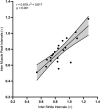Muscle activity variability patterns and stride to stride fluctuations of older adults are positively correlated during walking
- PMID: 38007498
- PMCID: PMC10676363
- DOI: 10.1038/s41598-023-47828-9
Muscle activity variability patterns and stride to stride fluctuations of older adults are positively correlated during walking
Abstract
It has been found that fractal-like patterns are present in the temporal structure of the variability of healthy biological rhythms, while pathology and disease lead to their deterioration. Interestingly, it has recently been suggested that these patterns in biological rhythms are related with each other, reflecting overall health or lack of it, due to their interaction. However, the underlying neurophysiological mechanisms responsible for such dependency remain unknown. In addition, this relationship between different elements needs to be first verified before we even pursue understanding their interaction. This study aimed to investigate the relationship between two elements of the neuromuscular system, gait and muscle activity variability patterns in older adults. Twenty-one older adults walked at their preferred walking speed on a treadmill. Inter-stride intervals were obtained through an accelerometer placed on the lateral malleoli to assess the temporal structure of variability of stride-to-stride fluctuations. Inter muscle peak intervals were obtained through the electromyographic signal of the gastrocnemius to assess the temporal structure of the variability of the simultaneous muscle activity. The temporal structure of variability from both signals was evaluated through the detrended fluctuation analysis, while their magnitude of variability was evaluated using the coefficient of variation. The Pearson's Correlation coefficient was used to identify the relationship between the two dependent variables. A significant strong positive correlation was found between the temporal structure of gait and muscle activity patterns. This result suggests that there is an interdependency between biological rhythms that compose the human neuromuscular system.
© 2023. The Author(s).
Conflict of interest statement
The authors declare no competing interests.
Figures


Similar articles
-
Stride-to-stride fluctuations and temporal patterns of muscle activity exhibit similar responses during walking to variable visual cues.J Biomech. 2024 Feb;164:111972. doi: 10.1016/j.jbiomech.2024.111972. Epub 2024 Feb 3. J Biomech. 2024. PMID: 38330885 Free PMC article.
-
Association between stride time fractality and gait adaptability during unperturbed and asymmetric walking.Hum Mov Sci. 2018 Apr;58:248-259. doi: 10.1016/j.humov.2018.02.011. Epub 2018 Mar 12. Hum Mov Sci. 2018. PMID: 29505917
-
Complexity, fractal dynamics and determinism in treadmill ambulation: Implications for clinical biomechanists.Clin Biomech (Bristol). 2016 Aug;37:91-97. doi: 10.1016/j.clinbiomech.2016.06.007. Epub 2016 Jun 28. Clin Biomech (Bristol). 2016. PMID: 27380204
-
Gait variability, fractal dynamics, and statistical regularity of treadmill and overground walking recorded with a smartphone.Gait Posture. 2024 Jun;111:53-58. doi: 10.1016/j.gaitpost.2024.04.002. Epub 2024 Apr 17. Gait Posture. 2024. PMID: 38636334
-
Gait dynamics, fractals and falls: finding meaning in the stride-to-stride fluctuations of human walking.Hum Mov Sci. 2007 Aug;26(4):555-89. doi: 10.1016/j.humov.2007.05.003. Epub 2007 Jul 5. Hum Mov Sci. 2007. PMID: 17618701 Free PMC article. Review.
Cited by
-
Effects of metronome walking on long-term attractor divergence and correlation structure of gait: a validation study in older people.Sci Rep. 2024 Jul 9;14(1):15784. doi: 10.1038/s41598-024-65662-5. Sci Rep. 2024. PMID: 38982219 Free PMC article.
-
High-dimensional cortical signals reveal rich bimodal and working memory-like representations among S1 neuron populations.Commun Biol. 2024 Aug 23;7(1):1043. doi: 10.1038/s42003-024-06743-z. Commun Biol. 2024. PMID: 39179675 Free PMC article.
-
The constrained-disorder principle defines the functions of systems in nature.Front Netw Physiol. 2024 Dec 18;4:1361915. doi: 10.3389/fnetp.2024.1361915. eCollection 2024. Front Netw Physiol. 2024. PMID: 39744508 Free PMC article. Review.
References
-
- Hausdorff JM, Cudkowicz ME, Firtion R, Wei JY, Goldberger AL. Gait variability and basal ganglia disorders: Stride-to-stride variations of gait cycle timing in Parkinson’s disease and Huntington’s disease: Gait Variability and the Basal Ganglia. Mov. Disord. 1998;13:428–437. doi: 10.1002/mds.870130310. - DOI - PubMed
MeSH terms
Grants and funding
LinkOut - more resources
Full Text Sources

